A Synchronous Machine Transient Model Based upon an Algebraic Loop Accounting for Nonlinearity and Cross-Magnetization
Abstract
The purpose of this paper is to carry out an alternative to the present transient models for field wound synchronous machines, which is able to take into account the nonlinearity of the magnetic materials as well as the cross-magnetization. After presenting the principal model structures according to the state variables, a model based on two lookup tables for the magnetizing flux linkages is introduced and built step by step. The resulting signal flowchart shows an algebraic loop within the model, where the main flux linkage rapidly converges to its instantaneous value by simple iteration. The proof of this convergence is given for both saturated and unsaturated machine. Even though the proposed model uses the total linkage flux as state variable, as many alternative models do, it does not require the inversion of the current to flux linkage function (i.e., of lookup tables). This can spare a heavy computational task, especially with very large lookup tables. In the proposed model, the computational effort in the worst case scenario is reduced to few iterations (<10). Finally, the nonlinear behavior of the model is verified in four different transient scenarios by comparing its outcomes with those of a linear model for the same test machine.
1. Introduction
The study of synchronous machines (SM) in nonstationary behavior has taken advantage of the Park theory since many decades. The separation of the combined actions of all machine magnetomotive forces (MMFs) along the two electrically orthogonal rotor magnetic axes makes the corresponding magnetic flux linkages independent from the relative position between rotor and stator. This simplifies in turn the solution of the electromechanical differential equations (DEs) which describe the machine behavior, since the machine self-inductance and mutual inductance become time invariant. Nevertheless, the nonlinearity of the magnetic properties prevents the problem to be simply solved by the theory of linear DE or the Laplace transform. Therefore, the numerical integration of DE by means of computational resources has become the main way to simulate SM-related transient phenomena making use of a d-q axis model. Transient related to the electric system dynamic stability [1, 2], symmetrical and asymmetrical faults [3, 4], load rejection [5], and asynchronous behaviors [6–8] have done large use of nonlinear SM models based on the d-q axis theory. In more recent time, the interest for the transient model of SMs has been awaken by the applications of embedded systems (ES) to the control of SM for industrial and traction applications [9–13]. In that case, the model is used in the observer of a driven motor, in order to predict its state variables. In this specific task, the model must fulfil not only the usual requirement to be accurate in the predictions but also to deliver them quickly. This fact well represents the observer dilemma between the complexity of the model on one side and the need for its computational lightness on the other side. For example, taking into account the nonlinearity and the cross-magnetization introduced by the ferromagnetic materials in a SM model [14, 15], it improves the outcome accuracy of the model itself, but it requires more computational resources. In order to tackle this computational problem, lookup tables (LUTs) [14, 16] are increasingly preferred to analytic formulas [17, 18] for implementing the nonlinearity and the cross-magnetization in SM models. In fact, LUTs can provide the armature flux linkage for a given magnetomotive force (MMF) just by entering a multidimensional numerical table and picking up its value. All that without getting the CPU involved in any sort of time-consuming calculation. Nonetheless, for the experimental and the computational determinations of the relationship between the flux leakages and the currents, see the currents as sources and the linked fluxes as outcomes [16, 17]. For this reason, the flux-linkage-to-current LUT, which is needed in the model using the flux linkage as state variable, cannot be measured or calculated straightforwardly. It must rather be obtained through the inversion of the current-to-flux-linkage function Ψ(i). In an ingenious closed loop [14, 16], control strategies have been invented, which are nested in a numeric iterative procedure, in order to obtain the flux-linkage-to-current LUT moving from an available current-to-flux-linkage one. Besides, the recourse to a SM model having the current as variable of state, which makes knowingly use of the straight function Ψ(i), does not lighten the calculation burden anyway, since a marginal inductance matrix l(i) of the machine and its inversion are also needed [17]. This paper offers a solution for using a SM machine transient model having all machine flux linkages as state variables, without any need for the inversion of the current-to-flux-linkage LUTs. The key idea for bypassing the issue of the Ψ(i) inversion is the recourse to LUTs which are related to the magnetizing flux linkages along the d-axis and the q-axis rather than to the whole flux linkages. Then, the machine currents can be alternatively obtained from the distance vector between the flux linkages and the main fluxes via a constant leakage matrix, which is related to the machine stray inductances. Therefore, particular attention is paid in this paper to the construction of the leakage matrix starting from the most suitable and general SM model. Moreover, provided an input for the machine state of magnetization together with the external electrical and mechanical constraints at a given time, it is proved that the proposed model converges necessarily to the instantaneous values of the state variables. In the part dedicated to the method, after having revised the possible structures for a SM model and introduced a complete SM d- q-axis model, the paper shows the linear proportionality between the machine currents and the distance vector between main and flux linkages. Hence, the alternative flux linkage-based model is built, and its convergence to the timely state variables is demonstrated. The model is tested on a 60 kVA, 400 V, 50 Hz salient pole synchronous machine (SPSM). The method for obtaining the related LUTs by means of FEM calculations is described in the appendix, whereas the implications of the nonlinearity and the cross-magnetization on the machine behavior are discussed in the paper body. The section dedicated to the results shows the simulations obtained by means of the novel model. Four different transitory behaviors have been simulated: (1) rapid transition from nominal excitation to underexcitation and back; (2) 10% sudden increase of the grid voltage; (3) rapid drop of the driving torque (-75%) under constant power factor; and (4) severe voltage sag (-60%) lasting several cycles. The results achieved through the proposed model are compared with the ones achieved for the same SPSM by a linear model (i.e., having constant d-axis and q-axis magnetizing inductances) in order to highlight the errors introduced in the results by neglecting nonlinearity- and cross-magnetization-related phenomena in the machine model.
2. Materials and Methods
2.1. A Novel Structure for the SM Model
In [19], it has been proved that by assuming the SM flux linkages or alternatively the currents as state variables, or even considering a combination of them, several different SM equivalent models can be obtained. Nevertheless, in the practical applications, the most recurrent models [17] are those represented in Figure 1. In particular, the model in Figure 1(a) assumes the armature flux linkage vector Ψ as a state variable whereas the model in Figure 1(b) uses the armature currents vector i to that end. The last model is straightforwardly apt to host a LUT that relates the flux linkage vector to the armature currents. In fact, as soon as the machine is considered anhysteretic, the function Ψ(i) becomes single-valued. Hence, it can be univocally approximated, in a domain D of the armature currents, by interpolating a finite number of its samples collected in a LUT. Since the anhysteretic assumption has the collateral drawback of disregarding part of the magnetic losses in the machine, they need to be reintroduced into the model later on. Fortunately, there are many available methods [9] for doing that, and this specific topic will therefore not be dealt in the present paper.
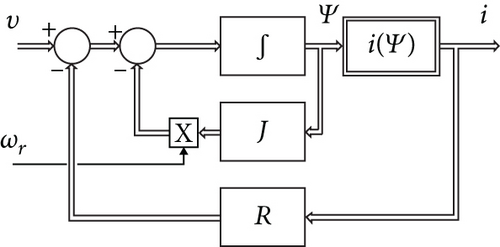
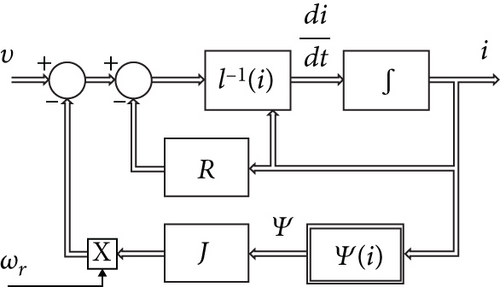
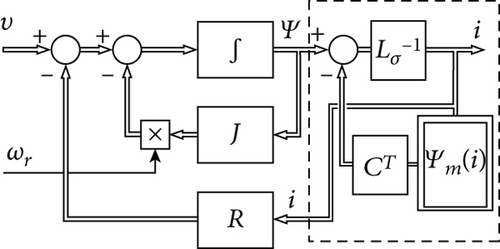
The novel model proposed by the present work is represented in Figure 2.
The following can be observed: (I) it keeps all flux linkages, not only those of the armature, as state variables; (II) it implements the function i(Ψ) of Figure 1(a) by combining a constant matrix , to be yet defined, and a nonlinear single-valued function Ψm(i), which represents the armature main flux linkages. Feature (I) spares the use of (1) in the model as well as the issue of its inversion, whereas feature (II) introduces the novelty of the suggested model. In particular, it does not require the construction of the inverse function i(Ψ) starting from Ψ(i) as shown in [14, 16], and it is applicable to reduced order observers as well, since its saturation model Ψm(i) works upon available current measurement/estimation rather than on flux linkage ones.
2.2. Stray Flux Linkages vs. Current Proportionality
A quite general Park model for a wound field salient pole synchronous machine (SPSM) is represented in Figure 3, where two armature circuits (outside the shaded circle) and three rotor circuits (inside the shaded circle) are considered. In particular, with reference to the rotor, there are the excitation circuit (f) and a single damper circuit (D) on the d-axis and a single damper circuit (Q) on the q-axis.
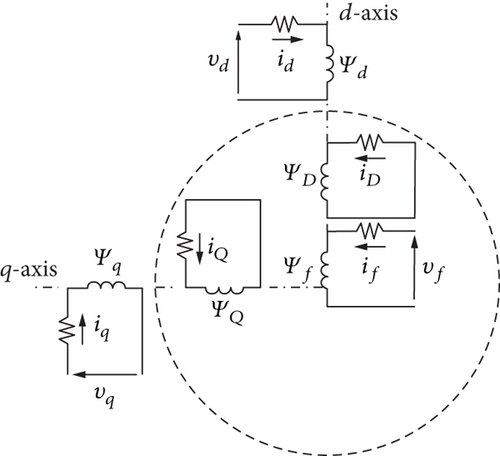
A more precise consideration of a round rotor SM (RRSM) would have required two more rotor circuits on both axes indeed: one for taking into account the presence of the massive and conductive rotor body and the other one for the eventual conductive slot wedges. In the same way, the consideration of a permanent magnet excited SM (PMSM) should replace the excitation winding in Figure 3 with a suitable and permanent source of MMF, in order to fit in the representation. Nevertheless, the circuits of Figure 3 are general enough for presenting the proposed model in its entirety.
Canay [20], Hiramatsu et al. [21], and Guorui et al. [22] have proved that (6) does not always hold. Not only the main fluxes but also the stray fluxes contribute to the mutual linkage between the circuits laying on the same magnetic axis. Figure 4(a) shows, e.g., that the magnetic coupling between the excitation winding and the D-damper bars in a RRSM takes place through the stray fluxes too. In fact, all rotor circuits, excitation winding and damper bars, are usually laid down in the same slots.
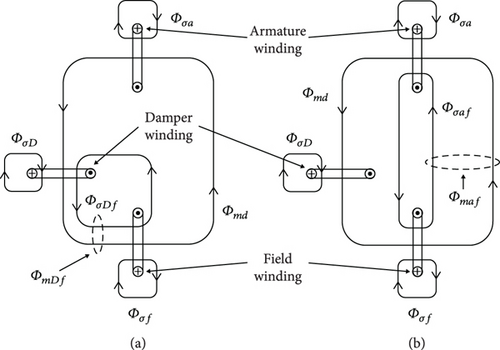
In this way, the main flux ΦmDf, shared between excitation winding and D-damper bars, becomes larger than Φmd, i.e., the flux they have in common with the armature. In a SPSM having grid-shaped damper bars on each pole, a part Φσaf of the magnetic flux Φmaf—produced by the armature and linked to the field winding—does not link the D-damper bars. Therefore, Figure 4(b) shows that the flux Φmd linking the D-damper circuit can be smaller than the flux Φmaf shared between the armature and the excitation winding. The practical consequence of these remarks is the introduction of an additional stray inductance in the usual Park model as shown in Figure 5. It takes into account the algebraic difference between the total main flux, which links the armature on the d-axis, and the total flux shared between field winding and D-damper circuit.
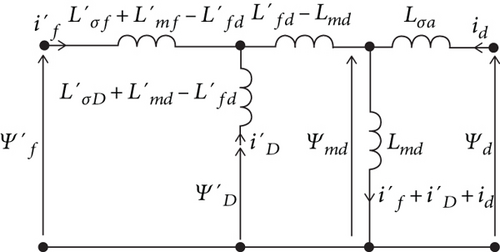
According to the observations presented above, it results that can be negative for SPSM while it is always positive for RRSM.
Since the circuits along the q-axis in Figure 3 are only two, there is just one quadrature main flux to be considered. Therefore, the equivalent magnetic circuit on the q-axis looks like the one represented in Figure 6.
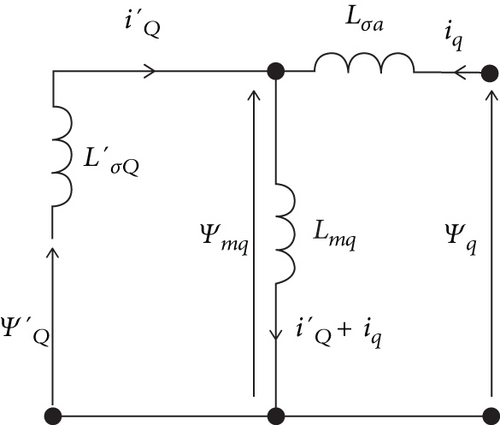
- (i)
Stray coefficient for the armature
()
- (i)
Stray coefficient between armature and field winding
() - (ii)
Stray coefficient between armature and D-damper circuit
() - (iii)
Stray coefficient between armature and field winding
() - (iv)
Stray coefficient between armature and Q-damper circuit
() - (v)
Armature shielding coefficient
() - (vi)
Field winding shielding coefficient
() - (vii)
D-damper circuit shielding coefficient
()as well as the machine anisotropy factor at nominal conditions()
When studying (10)–(17) closer, it can be recognized that the stray and the shielding coefficients can be regarded as constants. In fact, they represent ratios where numerators and denominators vary according to the same underlying nonlinear magnetization characteristics, irrespective to d-axis or q-axis consideration. Adding that and AFN are also constants, it can be concluded that (19) is a constant matrix and that (7) sets a linear proportionality between the vector of the stray fluxes and the vector of the machine currents.
2.3. Variable Convergence within the Algebraic Loop
Expression (42) fulfils condition (36) for the convergence. In fact, even assuming an unrealistically large armature stray inductance of about 30%, the d-axis inductance should be at least 10 times larger than the q-axis one in order to have >1.
Due to the local monotonic nature of the magnetization functions (30), it must be expected the transition from (42) to (45) to be also monotonic, to ensure the convergence (35) for every simulated machine behavior between saturation and nonsaturation.
2.4. Model Implementation
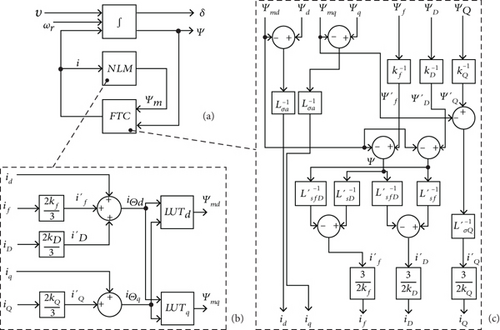
The transformed currents, which provide their MMFs on the same d- or q-axes, are summed up in order to determine the armature equivalent magnetizing currents and , respectively. The LUTd reproduces the function shown in Figure 8(a), whereas LUTq reproduces the shown in Figure 8(b). One possible way to build the lookup tables for a given SM by using a FEM analysis program is duly described in the appendix to the present work.

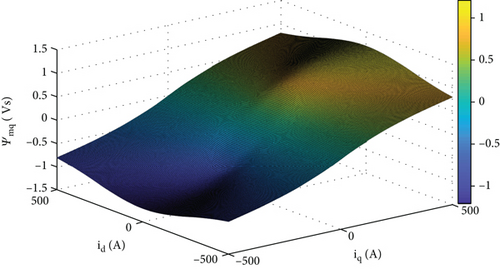
As soon as the coordinated magnetizing current is introduced in the LUTs, two values for the armature main flux linkages are returned as outputs, Ψmd and Ψmq, respectively.
These quantities provide the inputs for the flux-to-current (FTC) block in Figure 7(c) together with the vector of the flux linkages Ψ. The rotor-related flux linkages must be referred to the armature side by means of the ratios (46). Then, as already shown in (7), the block performs a linear combination of the linked stray fluxes through the matrix , in order to get an estimate of the machine currents. The currents obtained by that way are all referred to the armature side. Therefore, the rotor-related currents need to be referred back to the rotor by using the usual ratios (46).
2.5. Performed Test Simulations
The proposed nonlinear model for SM has been tested on the wound field SPSM (WFSPSM) shown in Figure 9, the parameters of which are given in Table 1.
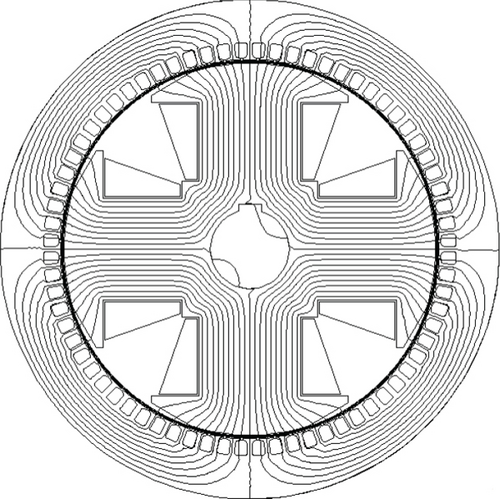
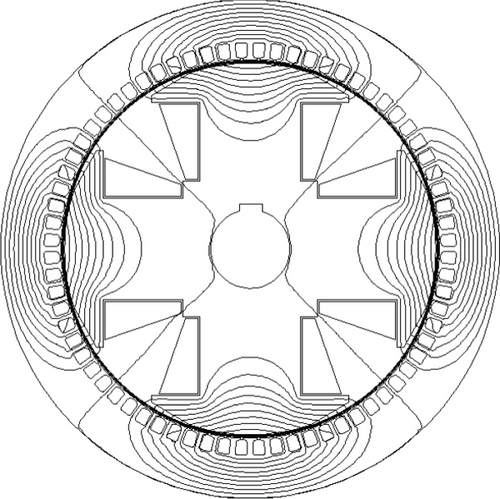
| Symbol | Description | Value |
|---|---|---|
| AN | Rated power | 60 kVA |
| VN | Rated voltage | 400 V |
| nN | Rated speed | 1500 rpm |
| fN | Rated frequency | 50 Hz |
| cos φN | Rated power factor | 0.9 |
| δmin ⋯ δmax | Airgap range at the pole shoe | 3.2 ÷ 5.7 mm |
| αp | Pole coverage | 0.76 |
| li | Active axial length | 184 mm |
| rδ | Airgap average radius | 161 mm |
| q | Slots per pole per phase | 6 |
| ns | Conductors per slot | 8 |
| r | Armature phase resistance (p.u.) | 6.2 · 10−2 |
| rf | Field winding resistance (p.u.) | 5.8 · 10−3 |
| rD | d-axis damp. circuit resistance (p.u.) | 7.7 · 10−3 |
| rQ | q-axis damp. circuit resistance (p.u.) | 15.3 · 10−3 |
|
|
Nominal d-axis reactance (p.u.) | 1.32 |
|
|
Nominal q-axis reactance (p.u.) | 0.72 |
| AFN | Nominal anisotropy factor | 0.83 |
| σa | Armature stray factor | 5.2% |
| σaf | Field winding to armature stray factor | 9.7% |
| σaD | Armature to d-axis damper circuit stray factor | 11.8% |
| σQ | q-axis damper circuit stray factor | 13.3% |
| μa | Armature shielding coefficient | 1.7% |
| μf | Field winding shielding coefficient | 9.5% |
| μD | q-axis damper circuit shielding coefficient | 11.7% |
In order to prove the capability of the suggested model in handling the nonlinearity and the cross-magnetization in the test machine, the model itself has been compared with a linear and anisotropic one, where the LUTs of Figure 7(b) have been replaced by constant magnetizing inductances Lmd and Lmq. The latter has been chosen, for each led test, so as to match the initial conditions of the nonlinear model, before an external cause intervenes to push the machine away from its initial steady state. In this way, the two models are aligned at the beginning of the test, and all subsequent divergences between them can be recognized more clearly. In particular, four tests have been envisaged, that, for the nature of the chosen perturbation, end up changing the magnetizing flux and highlighting the magnetic nonlinearity of the machine.
The first test foresees the sudden drop of the excitation voltage from its nominal value down to 40% of it, while the nominal driving torque of the generator is kept constant. Therefore, the generated nominal active power remains unchanged. Due to the lack of exciting MMF, the machine must require the magnetizing current from the grid, moving by that from the generation to the consumption of reactive power.
The second test is based on the observation that the voltage level at the generator bus bar is responsible for the incoming/outgoing reactive power. Therefore, a grid voltage increase, when the excitation current is kept constant, results in a higher magnetizing flux in the SM. This should in turn shift the generator towards the saturation and possibly highlight its underlying nonlinear behavior.
The third test reproduces the adjustment of the excitation current when the generated power is suddenly reduced down to 25% of its nominal value. In order to keep the power factor constant, the excitation current is decreased accordingly, so that the exciting MMF is drastically reduced.
The fourth and final simulations deal with a low-voltage fault ride through (LVFRT), where the grid voltage experiences a severe sag, like the one (class 3) foreseen for the industrial environment, in the reference standard for EMC tests EN61000-4-34. By increasing the duration of the sag, the stability limit for the SM is detected. The comparison between the limits—achieved through the linear and nonlinear model, respectively—should show to what extent the nonlinear magnetization matters in modelling stability problems.
3. Results and Discussion
3.1. Excitation Voltage Step Test
Figure 10 shows the instantaneous drop of the SM excitation voltage, at the time t = 3 s, in the test machine providing the nominal power at the nominal conditions. This change in the control voltage produces a subsequent and slower drop of the excitation current.

It is not possible to observe any substantial difference between the resulting field currents for the nonlinear and linear model, since the d-damper bars screen the field winding from the large variations of the armature MMFs occurring during the transient. Figure 11 shows that the d-axis component of the armature current drops almost to zero whereas the q-axis one increases.
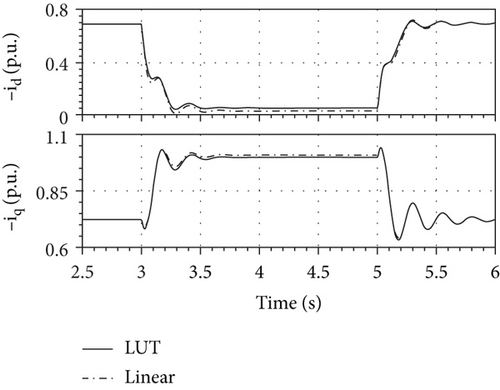
Inequality (52) proves that the magnetizing inductance of the nonlinear model senses the transition from the over excitation to the under excitation, since its value increases when the magnetizing flux decreases. The transition from the over excitation to the under excitation is given also from the graph of the reactive power in Figure 12.
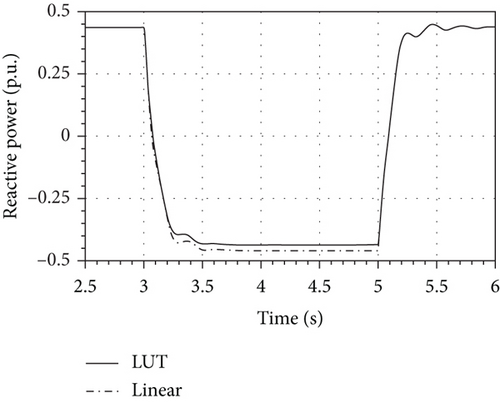
The larger value of the |iq| in the linear model observed in (51) together with (53) explains the discrepancy between the answers of the two models shown in Figure 12.
3.2. Grid Voltage Step Test
In this test, while the generator is providing 60% of the nominal power at cos φ = 0.9 (lagging), a stepwise 10% increase of the grid voltage occurs at t = 2 s. In Figure 13, it can be observed that the two models give a different account of the d-axis and q-axis currents in the final steady state, as well as of the generator load angle, as it is shown in Figure 14. In particular, Figure 14 shows, firstly, that the load angle δ decreases moving from the initial steady state to the final one and, secondly, that the linear model provides a smaller load angle for the final steady state, δlin, than the one given by the nonlinear model, δLUT.
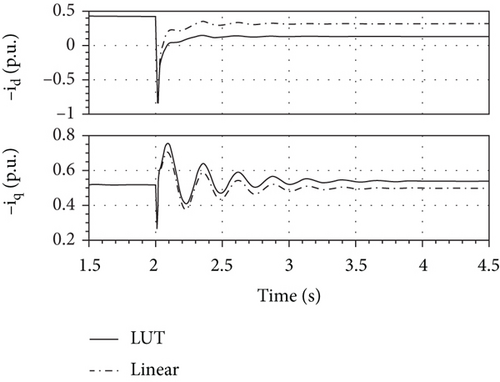
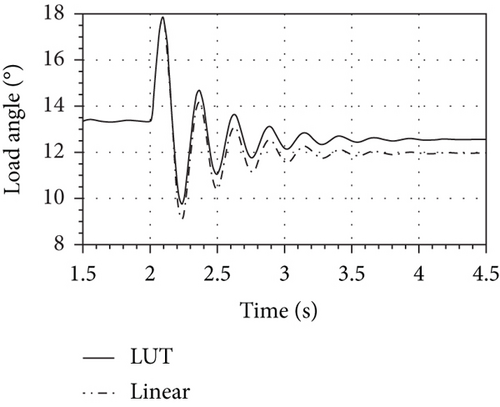
Moreover, since the excitation of the SM and its driving torque are kept constant, the generated active power does not change when the transient response fades away, whereas the reactive power does (Figure 15). The nonlinear model gives account of a drop in the reactive power provided by the generator, which is larger than the one reported by the linear model.
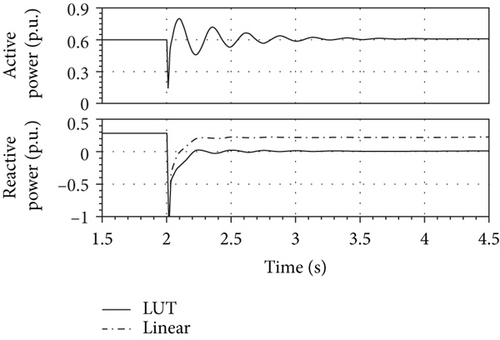
Figure 16 helps to interpret and check the different results shown in Figures 14 and 15.
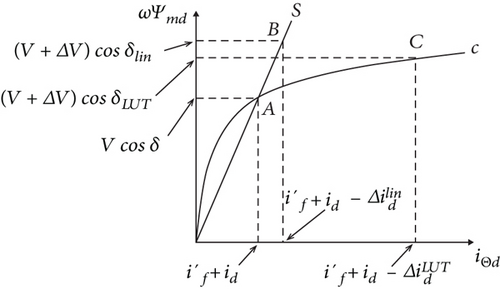
In (54), the voltage drop on the armature stray inductance is neglected, since it is irrelevant to the present line of reasoning.
3.3. Driving Torque Step Test (at Constant Power Factor)
The present test foresees a driving torque drop from 100% down to 25% of its nominal value within 0.1 s. At the same time, in order to target the same initial power factor (0.9 lagging) in the final steady state, the excitation current is decreased accordingly. Figure 17(a) shows the needed adjustments of the field current whereas Figure 17(b) and the generated active power.
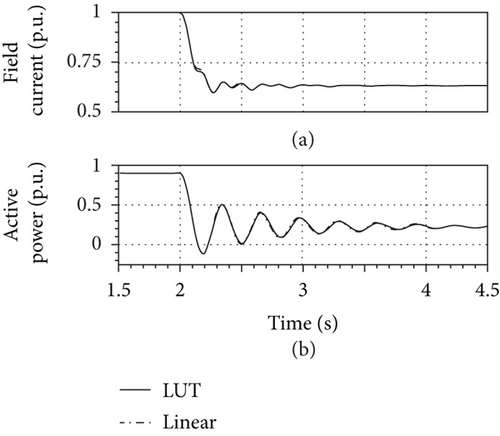
Even though Figure 17 does not present relevant differences between the answers of the two models, in Figure 18, they give a different account for the envelope of the armature phase current amplitude.
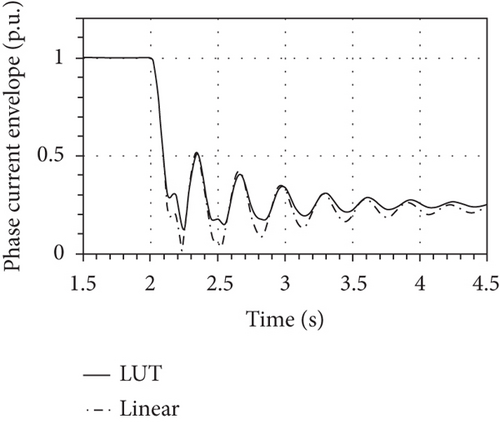
The mismatch between the two answers depends mainly on the direct axis current, as Figure 19 reveals by showing the different steady-state values for the reactive power.
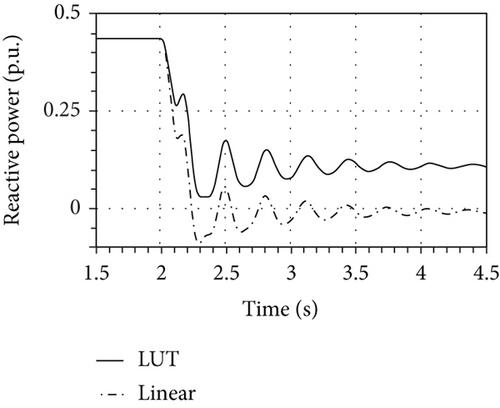
Since the load angle δ decreases due to the drastic drop of the generated active power, so that cosδ≅1, the Ψmd plays the main role in producing the difference between the two steady-state values of id provided by the models. Figure 20 shows how the magnetic work point in the linear model moves from A to B along the straight s, until the main flux Ψmd(B) is set through the constant magnetizing inductance and the superposed effects of the currents and .
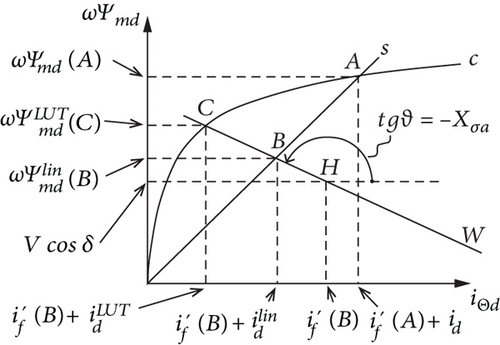
3.4. Low-Voltage Fault Ride Through
In the following last test, two voltage sags with the same intensity (-60% of the nominal grid voltage) but different duration (14 and 18 cycles, respectively) are applied to the armature of the SM. The response of the generator is simulated by means of the two models under comparison. This test, which evaluates the capability of the SM to keep the pace when the disturbance is over, represents a LVFRT test. Figure 21 shows that both machines keep the pace for a sag duration of 14 cycles. No substantial differences between the final steady-state values of the load angle can be recognized.
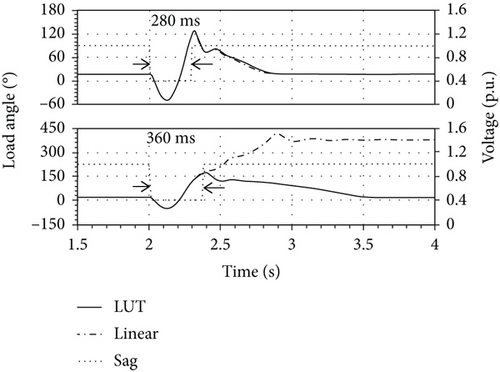
In the same figure, for a duration of the sag of 18 cycles, the nonlinear model proves the SM to be able to keep the pace after the sag, whereas the linear model does not.
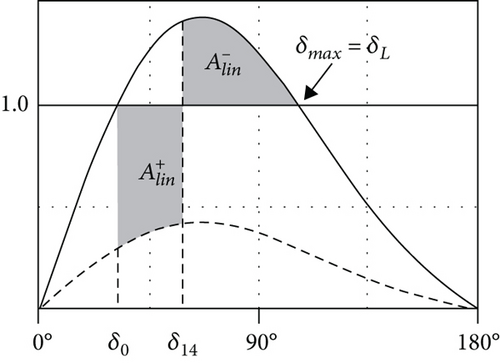
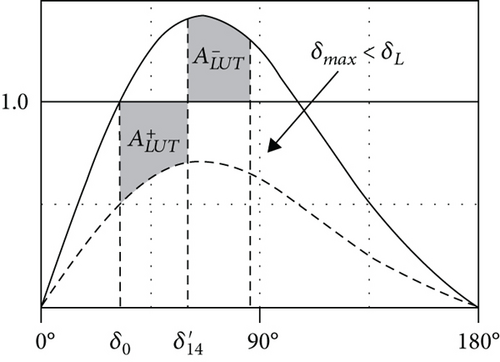
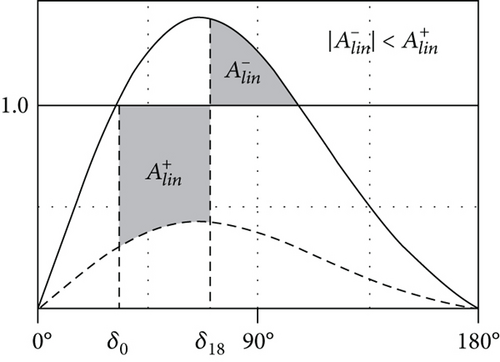
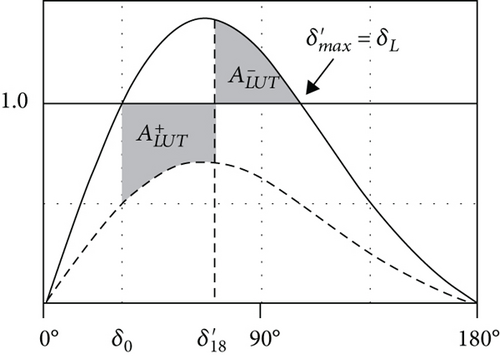
In studying Figure 22, it emerges that the nonlinearity of the SM magnetic circuit confers to the machine itself, a given capability to withstand grid voltage sags. Neglecting the said nonlinearity in the SM model leads to underestimating the machine performances during LVFRT tests.
3.5. Anisotropy and Cross-Magnetization: 1 or 2 LUT?
Hence, it seems impossible to give a correct account of the cross-magnetization by using the information coming from just one single LUT.
With reference to the anisotropy factor AF instead, in many works, the ratio between Ld and Lq is kept constant, even though it proves to be strongly dependent on the intensities of id and iq and on their relative ratio. In Figure 23, the AFm (see the appendix for its definition) for the test SM of Figure 9 has been represented. It gives an evidence of the fact that the anisotropy of a SM is in general not constant. It tends to fade away for very deep saturation, since the magnetic circuit reluctance along the d- and q-axes becomes comparable in magnitude. Even more important is the fact that the cross-magnetization contributes to foster the anisotropy of the machine. It is possible to observe this fact in Figure 23, where the anisotropy factor shows higher values along two crossed versants, which run along the 1st to 3rd and 2nd to 4thid-iq quadrant directions. This is probably due to the competing action of the coordinated MMFs on the material polarization, which prevents one axis to reach the full saturation when the other one is excited at the same time.
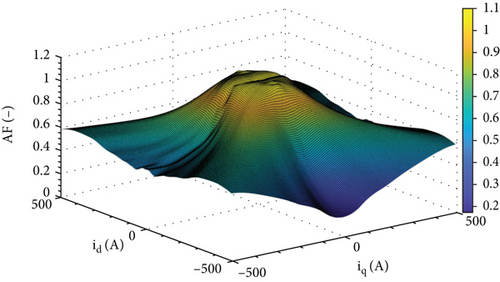
3.6. An Estimate for the Convergence Speed of the Algebraic Loop in the Model
After calculating the upper bound Msat = 0.351 in (45) by means of (28) and (29), the maximal number of iterations (67) reducing the initial error about one thousand times (ε = 10−3) is k = 7.
4. Conclusions
A two-axis theory-based SM model has been presented, which takes into account the nonlinearity of the SM magnetic circuit as well as the cross-magnetization. These performances are achieved by using two LUTs that reproduce the magnetizing flux linkages of the machine armature. Following this authors’ choice, the outlined model does not need any inversion of the current-to-flux-linkage LUT, even if the model maintains the flux linkages as state variables. This is possible thanks to a LUT-centered algebraic loop, which is intrinsic into the model and whose iterations always converge to the instantaneous machine main flux. The proof for the convergence of the introduced algebraic loop has been given for both cases of nonsaturated and saturated machines. The novel SM model has been successfully tested for the simulation of a wholly specified salient pole synchronous generator. Four different transient scenarios have been considered, where as many external disturbances provoke a substantial perturbation on the machine main fluxes, so to highlight the magnetic nonlinearity at play in the model. The outcomes have been compared with those of a traditional linear Park model for the same SM, giving a punctual interpretation and explanation of the occurred discrepancies.
All tests performed have shown that neglecting the nonlinearity of the machine magnetization characteristic leads to remarkable divergences between the two model outcomes. Finally, the construction of the main flux linkages LUTs for the test SM has highlighted the importance of a correct account of the machine magnetic anisotropy. In particular, the assumption of a constant ratio between the d-axis and q-axis armature inductances cannot be representative of all machine behaviors. In fact, the anisotropy of the SM depends not only on the absolute values of the direct and quadrature armature currents but also on their ratio. Moreover, it has been found out that the cross-magnetization leaves a recognizable signature on the machine magnetic anisotropy profile and that this fact cannot be reproduced by using one single LUT in the model. For all exposed reasons, the authors believe that the proposed model can be of a certain interest for those who perform simulations of SM in classic power systems applications, as well as in the control tasks of the modern electric drives. In this last field, this model can be used in reduced order observers, since its underlying mechanism for reproducing the magnetic nonlinearity relies on the use of the measured currents rather than on the flux linkages.
Symbols
-
- i:
-
- Current vector
-
- id:
-
- d-axis component of the armature voltage
-
- iq:
-
- q-axis component of the armature voltage
-
- iD:
-
- Current in the d-axis rotor damper circuit
-
- iQ:
-
- Current in the q-axis rotor damper circuit
-
- if:
-
- Excitation current
-
- I:
-
- Rotor moment of inertia
-
- J:
-
- Cross-matrix for the stator motional EMFs
-
- l:
-
- Matrix of the marginal inductances
-
- lm:
-
- Matrix of the marginal magnetizing inductances
-
- :
-
- Inverse Matrix of the stray inductances
-
- :
-
- Field winding stray inductance seen from the armature
-
- :
-
- Field winding main inductance seen from the armature
-
- :
-
- Direct axis damper circuit stray inductance seen from the armature
-
- :
-
- Direct axis damper circuit main inductance seen from the armature
-
- :
-
- Mutual inductance between the direct axis damper-circuit and the field winding
-
- :
-
- Mutual inductance between the armature and the field winding
-
- :
-
- Mutual inductance between the direct axis damper-circuit and armature
-
- Lmd:
-
- Main or magnetizing direct axis inductance
-
- :
-
- Q-circuit stray inductance seen from the armature
-
- R:
-
- Park-matrix of the resistances
-
- v:
-
- Voltage vector
-
- vd:
-
- d-axis component of the armature voltage
-
- vq:
-
- q-axis component of the armature voltage
-
- vf:
-
- Excitation voltage
-
- Ψ:
-
- Flux linkage vector
-
- Ψm:
-
- Main flux linkage vector
-
- Ψd:
-
- d-axis armature flux linkage
-
- Ψq:
-
- q-axis armature flux linkage
-
- Ψmd:
-
- d-axis magnetizing flux linkage
-
- Ψmq:
-
- q-axis magnetizing flux linkage
-
- :
-
- D-damper circuit flux linkage seen from the armature
-
- :
-
- Q-damper circuit flux linkage seen from the armature
-
- :
-
- Field winding flux linkage seen from the armature
-
- ωr:
-
- Rotor angular speed.
Disclosure
The research presented in this paper was carried out as a part of “Swedish Hydropower Centre (SVC).”
Conflicts of Interest
The authors declare that there is no conflict of interest regarding the publication of this paper.
Acknowledgments
SVC has been established by the Swedish Energy Agency, Energiforsk and Svenska Kraftnät together with Luleå University of Technology, KTH Royal Institute of Technology, Chalmers University of Technology, Uppsala University, and the Faculty of Engineering at Lund University. Participating companies and industry associations are as follows: AFRY, Andritz Hydro, Boliden, Fortum Sverige, Holmen Energi, Jämtkraft, Jönköping Energi, Karlstads Energi, LKAB, Mälarenergi, Norconsult, Rainpower, Skellefteå Kraft, Sollefteåforsens, Statkraft Sverige, Sweco Sverige, Tekniska verken i Linköping, Uniper, Vattenfall R&D, Vattenfall Vattenkraft, Voith Hydro, WSP Sverige, and Zinkgruvan.
Appendix
One way for populating the LUTs by using the values of (A.11) and (A.12) is that of obtaining the radial flux density distribution Bn(pα) of the SM by a FEM calculation. The latter is nested in a loop which provides the phase currents (A.4) to the FEM program, which are needed for supplying the armature. In this way, the resulting magnetizing flux linkages Ψmd and Ψmq are univocally related to the ordered pairs of id and iq, respectively.
Open Research
Data Availability
The data that support the findings of this study are available from the corresponding author upon reasonable request.




